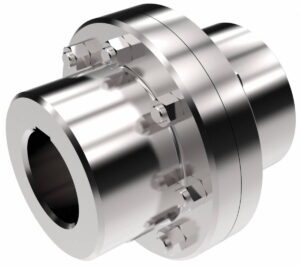What is a pinion coupling? Structure, applications and important selection points
In industrial power transmission systems, the choice of coupling type plays a vital role in the safe and smooth operation of the devices. One of the most widely used types of flexible couplings is the Pin Bush Coupling, which is used in many industrial machinery due to its simplicity in design, high durability, and ability to absorb vibration.
What is a pinion shaft coupling?
A pin-and-rod coupling is a type of flexible mechanical coupling that consists of two metal flanges and several pins (steel pins). These pins are placed inside rubber or polyurethane bushings and act as shock and vibration absorbers.
The structure of this coupling allows torque to be transmitted safely and without additional tension between two shafts that are not exactly aligned.
Components of a pinion coupling
-
Flanges:
Two metal pieces that attach to the ends of shafts. -
Pins (steel rods):
The connecting element between the flanges that are placed inside the rubber bushings. -
Rubber or polyurethane bushing:
They act as a shock absorber between the pin and the flange.
Pinion shaft coupling features
-
Ability to absorb vibrations and shocks
-
Tolerance of slight angular and radial misalignment between shafts
-
Easy installation and maintenance
-
Long life and wear resistance
-
Can be used in heavy duty conditions
Applications of pinion couplings
Mill-pin couplings are used in various industries, especially in devices that require smooth power transmission and reduced mechanical stress. Some common applications include:
-
Electric motors
-
Pumps
-
Industrial fans
-
Conveyors
-
Vibrating feeders
-
Industrial mixers
-
Material conveying devices such as screw conveyors and pneumatic conveyors
Advantages over other types of couplings
Compared to other types such as Rotax couplings or gear couplings , the pinion type has certain advantages:
| Comparison | Millpin coupling | Rotax coupling | Gear coupling |
|---|---|---|---|
| Vibration absorption | ✅ Top | ✅ Medium | ❌ Low |
| Maintenance cost | ✅ Low | ✅ Medium | ❌ Up |
| Abrasion resistance | ✅ Top | ✅ Medium | ✅ Top |
| Easy installation | ✅ Yes | ✅ Yes | ❌ Need for skills |
Important points when choosing a pinion coupling
-
Exact shaft dimensions and required torque
-
Material of pins and bushings
-
Device type and working environmental conditions (temperature, humidity, dust)
-
Easy replacement of bushings in case of damage
Periodic maintenance and inspection
To maintain optimal performance of the Milpin coupling, it is recommended:
-
Periodically check the rubber bushings for cracks or wear.
-
Keep flange and pin connections tight and free of looseness.
-
Avoid contact of the bushings with oily and chemical materials.
Conclusion
Pinion shaft couplings are an ideal choice for power transmission in demanding industrial conditions. With their simple design, shock and vibration absorption, and easy maintenance, they are one of the most widely used coupling types in various industries. If you are looking for a reliable and economical solution for coupling between shafts, this type of coupling is a good choice.

